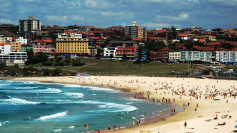On Monday, a new fissure opened north of the Icelandic volcano that started erupting last month, forcing the evacuation of hundreds of tourists.
The new fissure, first spotted by a sightseeing helicopter, is about 550 yards long but poses no immediate danger to life because it is far from hiking trails, according to the Icelandic Department of Emergency Management.
Despite this, the entire area was evacuated.
According to geophysicist Magnus Gudmundsson, the volcano's activity may be entering a second stage and moving north.
"We now see less lava coming from the two original craters," Gudmundsson said. "This could be the beginning of second stage."
Icelandic media published drone footage, showing the lava fountains feeding lava flowing into a nearby valley.
On the evening of March 19 on the Reykjanes peninsula, a volcanic eruption began after weeks of seismic activity with well over 50.000 earthquakes. The eruption began north-east of Grindavik, in a valley called Geldingadalur near Fagradalsfjall mountain, about 30 kilometers (19 miles) south of Reykjavik, Iceland's capital and largest city.
It is the peninsula's first recorded eruption in around 800 years. Over the past 6,000 years, the Fagradalsfjall volcano has been dormant. The eruption has been called Geldingadalsgos ("Geldingadalur eruption").
Despite the country's partial lockdown to combat the coronavirus, the volcano's proximity to Iceland's capital about 32 kilometers (20 miles) away, has drawn a steady stream of tourists to the region. According to the Icelandic Tourist Board, approximately 30,000 people have visited the area since the eruption began.
Iceland, which is situated above a volcanic hot spot in the North Atlantic, has one volcanic eruption every four to five years on average. The most recent one occurred in 2014 at Holuhraun, when a fissure eruption spread lava the size of Manhattan across the interior highland region.






